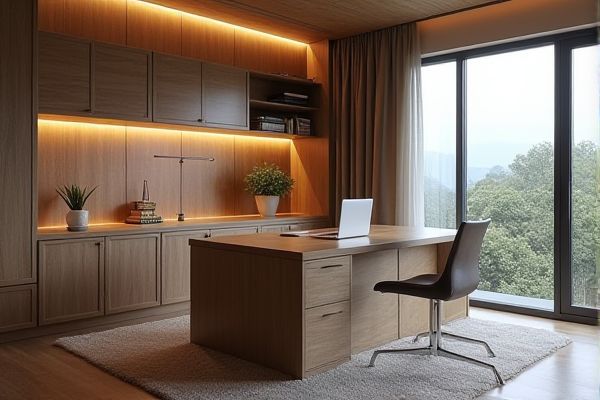
Flip top desks offer excellent space-saving solutions by allowing the desktop to fold vertically, making them ideal for compact rooms or flexible workspaces. Understanding the key differences between flip top and sliding desks will help you choose the perfect design for your needs; explore the rest of the article to find out more.
Table of Comparison
| Feature | Flip Top Desk | Sliding Desk |
|---|---|---|
| Design | Hinged top that flips up or down | Sliding surface that moves horizontally |
| Space Efficiency | Compact when closed, ideal for small areas | Adjustable tabletop doubles workspace |
| Ease of Use | Simple flip mechanism, quick access | Smooth sliding motion, flexible positioning |
| Durability | Hinges may wear out over time | Tracks may require maintenance |
| Ideal For | Home offices, compact rooms | Creative workspaces, multi-tasking |
| Price Range | Generally affordable | Moderate to high, depending on mechanism |
Overview: Flip Top Desk vs Sliding Desk
Flip top desks feature a hinged surface that lifts up and folds down, maximizing space efficiency and providing easy access for cleaning or storage. Sliding desks offer a movable tabletop that glides horizontally, allowing users to adjust workspace dimensions without disrupting the setup. Both designs enhance functionality in compact environments but cater to different usability preferences and spatial requirements.
Key Features Comparison
Flip top desks feature a hinged surface that folds down to save space, ideal for small offices or rooms requiring flexible work areas. Sliding desks offer a horizontally moving desktop, enabling easy access to storage compartments or adjustable workstation layouts. Both desk types enhance ergonomic functionality, but flip top desks prioritize compact storage while sliding desks focus on seamless accessibility and customization.
Space-Saving Capabilities
Flip top desks offer superior space-saving capabilities by allowing the desktop to fold vertically, freeing up floor space when not in use. Sliding desks optimize space by enabling the workspace to extend or retract smoothly, ideal for tight areas requiring adjustable layouts. Both designs maximize room efficiency but cater to different needs: flip top desks excel in compact storage, while sliding desks provide flexible work surface management.
Ease of Access and Usability
Flip top desks offer quick and intuitive access by allowing you to lift the desktop vertically, making it ideal for spaces where immediate visibility and reach to contents are essential. Sliding desks enable smooth horizontal movement of the workspace surface, providing continuous access without lifting or moving items around, thus enhancing usability in multitasking environments. Both designs prioritize convenience, but your choice should align with how frequently and in what manner you access your work materials.
Durability and Build Quality
Flip top desks typically feature robust hinges and sturdy frames designed for frequent folding, offering excellent durability for dynamic office environments. Sliding desks often incorporate high-quality tracks and solid materials to ensure smooth motion and structural stability over time. Your choice should consider the specific build quality standards and material strength to maximize long-term usability.
Aesthetics and Design Options
Flip top desks offer a sleek, minimalist aesthetic with a modern appeal, often featuring clean lines and compact design ideal for contemporary spaces. Sliding desks provide versatile design options, incorporating smooth mechanisms and customizable surfaces that blend functionality with style, suitable for varied interior themes. Your choice between flip top or sliding desks depends on your preference for either a streamlined look or multifunctional design versatility.
Installation and Maintenance
Flip top desks feature straightforward installation requiring minimal tools and often include pre-assembled components, reducing setup time. Sliding desks demand precise alignment during installation to ensure smooth track operation and may require periodic lubrication and track cleaning for optimal maintenance. Both designs prioritize user convenience but differ in maintenance frequency and complexity due to their mechanical structures.
Cost Analysis
Flip top desks generally offer a more budget-friendly option with lower upfront costs and simpler construction compared to sliding desks, which tend to be pricier due to their complex mechanisms and materials. Maintenance expenses for sliding desks can be higher over time because of moving parts that require regular lubrication and occasional repairs, while flip top desks usually incur minimal upkeep costs. Your choice will depend on balancing initial investment with long-term durability and functionality needs.
Ideal Use Cases
Flip top desks are ideal for flexible workspaces and classrooms where quick setup and compact storage are essential, enabling easy room reconfiguration. Sliding desks suit environments requiring smooth lateral adjustments for collaborative tasks and ergonomic customization, often found in modern offices and design studios. Selecting between the two depends on space constraints, frequency of rearrangement, and user interaction needs.
Final Verdict: Choosing the Right Desk
A flip top desk offers compact storage and easy space-saving functionality, ideal for smaller rooms or dynamic workspaces. Sliding desks provide smooth access to workspace extensions, enhancing ergonomics and multitasking efficiency. Your choice depends on whether you prioritize space optimization or seamless surface expansion for your work habits.
 homyna.com
homyna.com